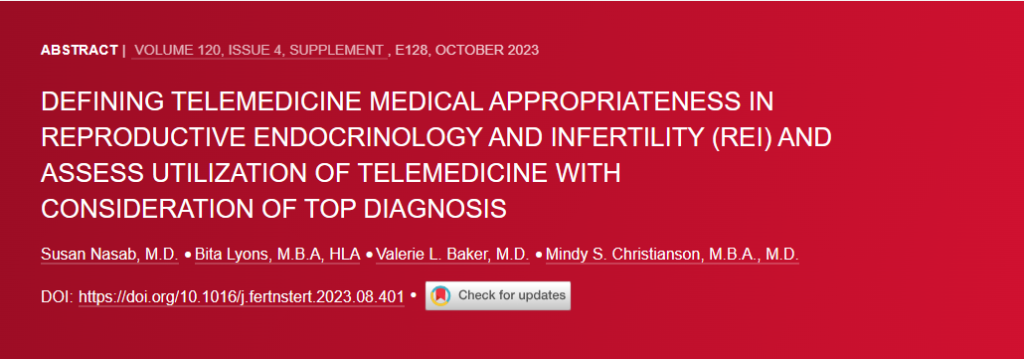Defining Telemedicine Medical Appropriateness in Reproductive Endocrinology and Infertility (REI) and Assess Utilization of Telemedicine with Consideration of Top Diagnosis.
DOI: 10.1016/j.fertnstert.2023.08.401Also available on ScienceDirect User License: Elsevier user license | Elsevier’s open access license policy
October 2023 | American Society for Reproductive Medicine
S. NASAB 1,2 , B. LYONS 3 , V. BAKER 1 , M. CHRISTIANSON1,4
1- Johns Hopkins Fertility Centre , Baltimore, MD, USA
2- Reproductive Fertility Canter, Irvine, CA, USA
3- Lyons Global, Sacramento, CA, USA
4- Cleveland Clinic Fertility Centre, Cleveland Ohio, USA
PURPOSE & OBJECTIVES
To compare diagnostic codes used for telemedicine vs office visits. To document if telemedicine had any influence on infertility practice…
MATERIALS & METHODS
Data sets from all REI visits in 3 fiscal years (2020-2022) were extracted and divided in two groups; office vs telemedicine.
The International Classification Diseases ( ICD) 10 and Current Procedural Terminology (CPT) codes of each visit were analyzed separately.
Top diagnoses were listed separately for each group. Patients were fit in the office group if they lived either out of state, or lived in the state where our physician was licensed for.
RESULTS
A total of 37,129 visits were reviewed during the study period, of which 6,845 were conducted via telemedicine.
We excluded CPT 91212 (established patient visits for 10-19 minutes), the code, which normally is used for office ultrasound monitoring visits due to its high volume and the need to be scheduled as office visits.
Top codes were defined as 99203, 99204, 99205, 21213, 21214 and 21215. Reviewing top codes in 11,791 total visits (6,704 were telemedicine visits) a continuous growth rate was seen in telemedicine visits compared to office visits (11%, 73%, 71%, in 2020, 2021 and 2022 respectively).
Similar trend was noted for CPT 99205, new patient visits for 60-74 minutes, which is used for new patient consultations, (5%, 72%, 70%, in 2020, 2021 and 2022 respectively). Moreover, excluding early pregnancy ultrasound visits, the top diagnoses were similar in the office and telemedicine groups.
Overall, infertility counseling and evaluation, recurrent pregnancy loss, polycystic ovarian syndrome, fertility preservation and irregular menstrual bleeding were the top 5 diagnoses.
Telemedicine can increase access to care, especially in subspecialties in which there are not providers in close geographic proximity to patients and for those living in rural areas . Additionally, telemedicine may be cost effective, and patients report high satisfaction with this type of care.
The primary objective of this QI project is to identify top diagnostic codes used for telemedicine visits at the Johns Hopkins Fertility Center to allow provider templates to be adjusted to preferentially schedule certain visit types and chief complaints as telemedicine visits.
We found that similar diagnostic codes were used for telemedicine and office visits in our practice. Using telemedicine, the total practice volume, and quality of patient care didn’t not get impacted and we continued to grow.
Results
CONCLUSIONS
Telemedicine visits can be used for new and established patients visits in REI practice, except for those which require physical examination or procedure.
In order to achieve an efficient and easy access to care both telemedicine and office visits should be available and offered to the patients.
REFERENCES
1- McGrowder, D. A., Miller, F. G., Vaz, K., Anderson Cross, M., Anderson-Jackson, L., Bryan, S., Latore, L., Thompson, R., Lowe, D., McFarlane, S. R., & Dilworth, L. (2021). The Utilization and Benefits of Telehealth Services by Health Care Professionals Managing Breast Cancer Patients during the COVID-19
Pandemic. Healthcare (Basel, Switzerland), 9(10), 1401.
2- A.G. Ekeland, A. Bowes, S. Flottorp. Effectiveness of telemedicine: a systematic
review of reviews Int J Med Inform, 79 (2010), pp. 736-771.
3- D. Grossman, K. Grindlay, T. Buchacker, K. Lane, K. Blanchard. Effectiveness and
acceptability of medical abortion provided through telemedicine Obstet
Gynecol, 118 (2011), pp. 296-303
4- Masciello, M. C., Bartholomew, A. J., Haslinger, M., Bozzuto, L. M., Tung, S. S.,
Thibodeau, R., & Tsiapali, E. V. (2019). Physician Perspectives on Fertility Preservation Discussions with Premenopausal Breast Cancer Patients: Results from a Multihospital Health Care System. Annals of surgical oncology, 26(10), 3210–3215.
5- Zwingerman, R., Melenchuk, K., McMahon, E., Liu, K. E., Siren, A., Laferriere, N., & Greenblatt, E. M. (2020). Expanding Urgent Oncofertility Services for Reproductive Age Women Remote from a Tertiary Level Fertility Centre by Use of Telemedicine and an On-site Nurse Navigator. Journal of cancer education : the official journal of the American Association for Cancer Education, 35(3), 515–521.




